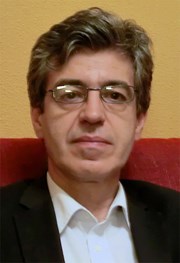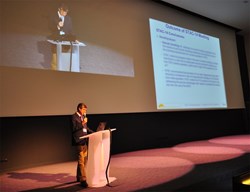
Joaquín Sánchez is Director of the CIEMAT National Fusion Laboratory in Spain and Chair of the ITER STAC.
The 14th meeting of the Science and Technology Advisory Committee (STAC) took place recently at the ITER Headquarters, from 14-16 May. We had the honour to be the first ITER Council subcommittee that met at the impressive Council chamber after it was inaugurated by the ITER Council last November.
The STAC advises the ITER Council on two areas: the monitoring of ongoing project activity and the assessment of new proposals which imply a change in the ITER Baseline. The work at every meeting is based on the "STAC charges" adopted by the ITER Council. We assess the input from the ITER Organization that replies to recommendations made by the STAC and answers questions implied in the STAC charges.
The preparation of each STAC meeting involves an important work load on key ITER Organization staff and, as Chair of the STAC, I am aware that we must be careful with the amount of work that our requirements put on ITER Organization resources. I must also recognize the high overall quality of the reports and presentations delivered to our committee.
One of the first agenda points since I have participated in the STAC is the review of the project schedule from a technical point of view. Essentially, we analyze the technical causes of delays, including aspects which are midway between the technical and the managerial world such as configuration control, quality control, process control, etc.
As is happened in previous meetings, STAC 14 continued to express its concern about delays in the project. A number of systems are "critical or supercritical," which means that they drive the First Plasma schedule, amongst them buildings, vacuum vessel, the poloidal field coils ... and even the toroidal field coils could come into this category if delays are not stemmed. In addition, the "microschedule" reflected in the milestone achievement index and similar management parameters also indicates delays. However my personal perception, and to some extent that of many STAC members, is that the processes are improving and that the project schedule will soon consolidate. The STAC also acknowledged the organizational efforts and the implementation of recovery plans in order to mitigate the delays.
As I explained during the meeting with the staff in the afternoon of 16 May, my personal view on the delays is that they are not dangerous per se for the project but they undermine our credibility in front of stakeholders and society and this is the actual danger. In order to rebuild credibility our best tool is to keep working hard, as everyone involved is already doing. The ITER project is not only extremely complicated technically, it is also a nuclear project, which adds complexity. It was conceived with a complicated collaborative structure and, unfortunately, an underestimated allocation of resources. The fact that it is effectively progressing and that many components are actually being constructed should encourage all of us.
In addition to the technical analysis of the schedule STAC also looked at deferrals, i.e., procurements which are proposed to be delayed in order to free resources for other items that are needed in earlier phases of the project. We were worried about the deferred implementation of some systems, in particular diagnostics, and we have requested the ITER Organization to make every possible effort to implement those systems in time in order to avoid delays to the deuterium-tritium campaign derived from a slow implementation of the research plan.

On 16 May, Joaquín Sánchez presented the outcome of the 14th meeting of the ITER Council Science and Technology Advisory Committee to the ITER staff.
During STAC-14 we noted that the organization and the progress of neutronics analysis has improved, for which we commended the ITER Organization. We have requested further detail on the results obtained for the next meeting of the STAC, in particular in relation to the heating of toroidal field coils and shutdown dose rates near the ports.
The news presented to the STAC on the central solenoid conductor was very good: in the last tests of a new cable developed by the Japanese Domestic Agency it showed very good stability—in fact, the degradation noted in earlier samples was essentially non-existing. Thus, we are now confident that the construction of the central solenoid can go ahead while keeping ITER's performance as originally planned.
This STAC had the responsibility to make a clear recommendation on an important technical decision: whether or not to include in-vessel coils for ELM control in the Baseline. After we evaluated the specific problems that a lack of ELM control could cause, in particular when operating with a tungsten divertor, our unanimous recommendation was to include the coils in the ITER Baseline. STAC concluded that the potential benefits of the use of the coils in achieving ITER's mission outweigh the risks, which were found to be very modest taking into account the solid design of the coils and the fact that they will be thoroughly tested during the non-nuclear phase.
STAC expects to make a recommendation next October for another key technical decision: the material for the first ITER divertor (tungsten or carbon).
At STAC-14 we analyzed the input from the ITER Organization regarding progress in divertor technology and tungsten divertor physics and the preliminary report prepared by the
ITPA topical groups, which provided an excellent in-depth review of what is known today concerning tokamak operation with high Z* walls. The results from JET and other devices give a positive view of the operation with tungsten divertor in ITER but impose some scenario restrictions that must be further considered for ITER. Experiments to be carried out at JET in the near future, aiming at local melting of some tungsten elements of the divertor, will provide important input for a final recommendation by the STAC on its next meeting.
A final element in the last STAC meeting was the monitoring of progress in a number of areas: remote handling, quality control, ion cyclotron, and negative neutral beam heating. On this last item STAC looks forward with interest to the recent start of activities in the
ELISE facility, which will provide important input to the physics and engineering design of the neutral beam injection sources for ITER.
In summary, STAC 14 corroborated important steps in the progress in the ITER project, which we expect to see reinforced next October thanks to the continued effort of all ITER Organization staff.
* A high Z element, like tungsten, is an element with a high
atomic number—its nucleus includes a large number of protons.



